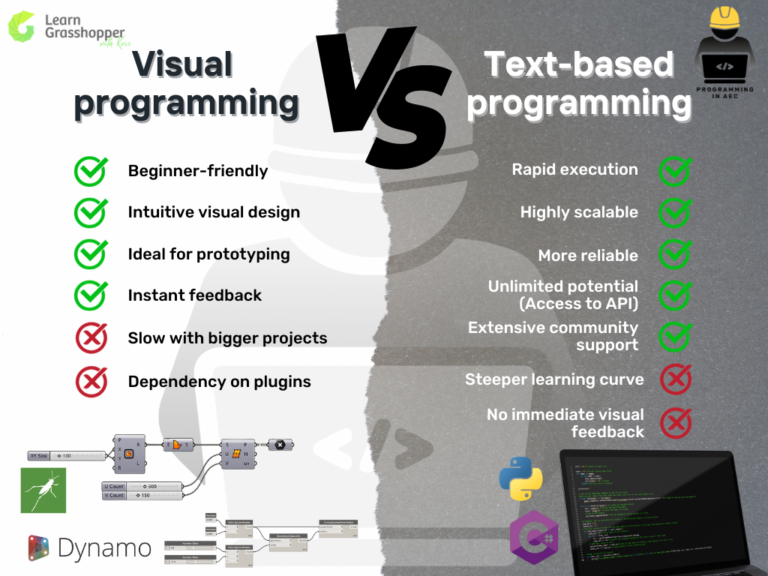After becoming comfortable with Grasshopper or Dynamo, you may wonder what’s next on your learning journey. Visual programming provides a fantastic introduction to the world of coding, mainly because of the instant results it offers. Every time I quickly prototype a simple script, it’s like a dopamine rush for my engineering mind. However, there’s so much more to explore. Here’s why Python and C# might be the next steps for your AEC projects.
Table of Contents
Grasshopper/Dynamo vs. Python and C#
At first glance, the difference between these might seem minor. However, direct coding doesn’t provide results as quickly as visual programming does. Every change in direct coding goes through a compilation phase. What’s the compilation phase? It’s when written code is turned into executable instructions. In contrast, visual programming often shows changes instantly without needing this step.
Traditional coding comes with a more challenging learning curve than the user-friendly nature of visual programming. Graphical concepts are generally easier for architects and engineers to grasp compared to a dense block of text. The immediate feedback from visual outputs can give the illusion that programming is simple. From personal experience, text-based programming demands more time and effort.
Python and C# inside Visual Programming
Every tool has its boundaries, and visual programming isn’t an exception. After a certain point, certain aspects, like slow processing speeds and cluttered wiring, can become frustrating. However, the real strength of platforms like Grasshopper and Dynamo is their ability to integrate custom scripts. By starting with the basics, you can replace things like basic “if” statements or employ functions not originally present in the software. As you progress, this approach becomes second nature and paves the way to advanced features, such as Open APIs or incorporating Chat-GPT into your visual scripts.
Where do text text-based programming languages win with visual programming?
See the list below where Python and C# stand out.
- Speed
We all value the visual intuitiveness of Grasshopper and Dynamo. However, as designs become increasingly complex, these tools can start to lag. With the rescue comes text-based programming. That’s why C# or Python can be used to optimize algorithms. Perhaps without overhauling the entire script, but by beginning with minor modifications and swapping out certain components, performance can be enhanced.
2. Clarity
Transitioning to text-based languages eliminates the mess of wires, providing a workspace akin to a tidy room. It also simplifies collaboration, especially when sharing scripts with others. This ensures that your code remains untouched.
3. Open API Access with Python and C#
You may have come across the term “Open API”. It stands for Application Programming Interface.
At a glance, it might come off as technical jargon, but think of it like a helpful waiter at your favourite diner. To put it simply: Just as a waiter takes your order to the kitchen, an Open API serves as a connector between software tools, ensuring they communicate smoothly.
Why the term “Open”? It indicates its wide accessibility. Much like a waiter serving various customers, an Open API caters to many users, albeit with varying degrees of user-friendliness.
And what’s the preferred language? In the AEC sector, C# holds prominence. Analogous to English being a global lingua franca, C# acts as a common language for many software applications, facilitating transparent interactions with the Open API. Nevertheless, due to Python’s simplicity and versatility, it’s gaining traction rapidly, and many software tools are accessible through it.
4. Security
Visual programming becomes limiting when specific plugins are unavailable. In larger companies, installing third-party components spontaneously is often restricted due to cybersecurity concerns, or there might be a waiting period until they’re verified as safe. Hence, having third-party components in plain code format is advantageous. It not only ensures security but also provides the flexibility to tailor the code to specific needs effortlessly.
5. More appropriate for bigger projects
From my observations, there’s only a marginal difference when it comes to minor tasks. However, performance significantly decreases when the number of instances grows from tens to hundreds. Handling tens of objects typically involves simpler automation tasks such as tagging, parameter management, or other minor activities. Challenges emerge when faced with increasingly complex and recurrent automation issues specific to engineering tasks.
Conclusion
While a background in visual programming is beneficial, it often falls short for daily difficulties, especially in the demanding world of design and engineering. A well-rounded skill set is essential, incorporating both visual and text-based programming. For one-off, unique tasks within a small team or project, visual programming, like Grasshopper and Dynamo, stands out for its speed, user-friendliness, and easy deployment. However, for larger, repetitive tasks spanning multiple projects and teams, integrating traditional programming skills becomes crucial. The decision is on your side, and it often depends on three core factors: Performance, Scalability, and Flexibility.















